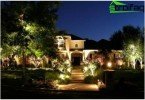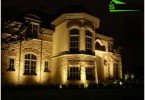How to make interesting garden lighting
Want to travel from a rational technological world to a mysterious, bewitching world of fairy tales and myths, where nature is rational, aesthetics are part of the natural order, a romantic miracle plume is floating in the air, and fantastic creatures are just waiting for the moment to jump under your nose and engage in festive round dance? Making dreams come true is easy – just make the right lighting for the garden, and the fairy tale will always be with you..
Content
- Lighting design in the garden landscape
- The main function – ease of movement
- An important decorative component
Lighting design in the garden landscape
Many owners try not only to build a beautiful and comfortable house, but also to ennoble its nearby surroundings. It is much more pleasant when the housing is surrounded by a well-kept garden or park, lined with paths, divided into cozy corners. But if during the day all the beauty of the landscape is already visible, then in the dark it is almost impossible to make out an unlit garden. So it turns out that when planning landscape design it is better to immediately take care of the necessary lighting. By the way, almost all tricks will come in handy even if you are going to decorate the lighting of the winter garden.
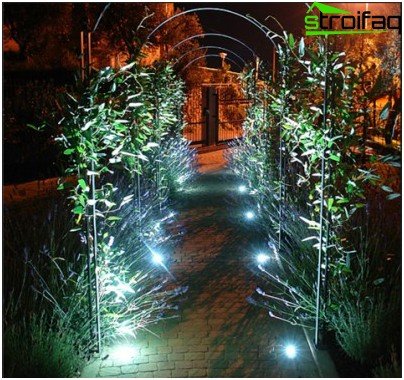
Decorative illumination of the “green tunnel”
Landscape lighting is divided into two categories:
- main lighting (functional): light sources are supplied to those areas where you walk, do business or just relax most often, such areas include household buildings, a porch and the area near the house, a fence, paths in the garden, various recreation facilities – arbors or shops
- decorative lighting: it all depends only on the imagination – your or your designer, because you can make the lighting almost everywhere – highlight a beautiful flowerbed, the most interesting trees, ponds, alpine slides and other decorations of your garden with a light spot or a network of small lights
Basically, nothing complicated, right? But the main thing that is worth paying close and biased attention is harmony. The harmonious combination of the landscape of the garden and park zone, architectural structures (first of all, your home) and decorative elements makes such a diverse territory a single symphony of taste and style.
The most experienced designers manage to coordinate the entire territory of a country house, not only in appearance but also in interior. The most striking example of this is the correspondence between the interior of the mansion and the view from the window.
The main function – ease of movement
When creating a network of main lighting, the owners mainly focus on the bright light falling from above, thanks to which you can freely navigate the terrain, move along paths without fear of tripping over, and do any business. Such light is obtained using high lights located in strategically important places. Since these lanterns differ in brightness and are located high from the ground, with the help of even one lamp a vast territory becomes clearly visible. And the only drawback of such lighting may be only its dazzle. Therefore, in lanterns of this kind, diffusing matte lampshades or fluorescent lamps with a softer shade of light are used.
When creating the main lighting, try to adjust it in such a way that most of the garden or park does not fall within its boundaries, otherwise decorative lighting will not work. With the help of flashlights of the searchlight type, it is possible to direct it only to those parts of the territory where bright light is really needed. By the way, on the walking alleys of the garden it is better to make the lighting muffled, more indicating the path than blinding the eyes. Such an illumination will be more harmoniously combined with the overall lighting design of the entire garden.
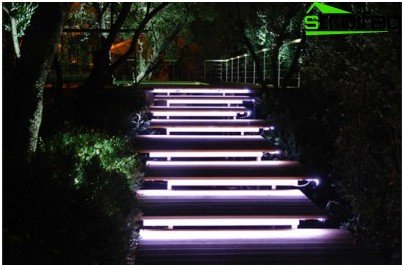
Functional and decorative illumination of the steps of the alley will ensure the safety of movement on the stairs in the dark
In addition to the constant shining of lights, experts advise other effects. For example, as a good addition to the main lighting, many choose motion sensors or a timer. Then, instead of constant excess lighting, you get a light that turns on only when necessary. Another good effect will be the use of a dimmer, which allows you to adjust the brightness of the lighting. When you appear, the light will light up, but if there are no people in the zone of lights, their brightness will be dimmed to the minimum.
An important decorative component
In order for the decorative lighting of the garden to be adequately picturesque, one should know the so-called “laws of the scene.” There are few of them:
- the creation of optical depth is achieved by different illumination of the three main zones, and the foreground lighting should be muted, not clogging, it is better to darken the middle plan (maximum – highlight some objects with directional light), but the background should be uniformly flooded with light
- the classic design effect is emphasized by the symmetrical arrangement of the highlighted objects
- To create the illusion of movement and rhythm of space, it is better to use the asymmetry of the backlight, as well as its transition from object to object (as in the New Year’s garland)
- the greatest clarity of the contours and the brightness of the colors of the illuminated object is obtained when using light of “cold” shades, which visually moves away the illuminated area
- warm light creates soft, comfortable lighting and the illusion of closer illumination
- the use of lamps of different colors in the backlight creates an extravaganza and a sense of celebration, however, experts do not recommend using more than three different colors when lighting one section
Using these laws, you can achieve the effects you need with the decorative illumination of a landscape gardening zone. Just remember that accent lighting is best done for outstanding features of the landscape, landscape or decorative architecture of the garden. Therefore, try to make it dark for several meters around the illuminated object – this is the only way you can emphasize the extraordinary charm of your garden.
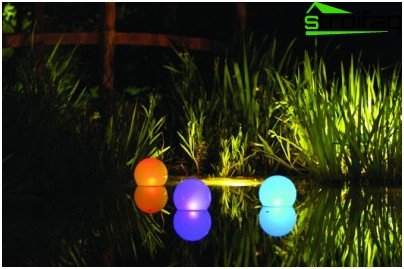
Illumination of the reservoir with floating colored lights will turn it into the abode of fairy-tale characters
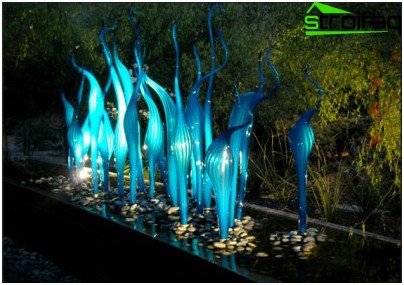
Original illumination of a small decorative pool
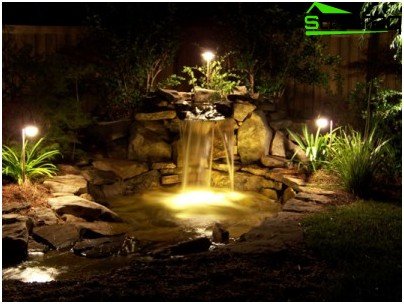
Decorative illumination of the waterfall will make you relax, watching the measured fall of water jets
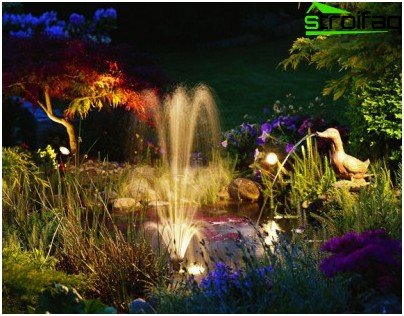
Decorative illumination of the fountain in the garden: you can realize the most fantastic ideas
What is most often used as objects of decorative illumination? Oh, there can be many such constructs, the only question is whether you use them all on your personal plot. So, to focus with the help of highlighting is:
- on statues or sculptures installed in the garden
- at fountains, pools and any other decorative reservoirs
- on original and unusual plants (flower beds, flower beds, trees)
- on decorative architectural forms (arbors, slides, terraces)
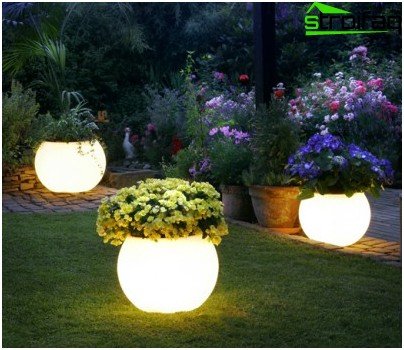
Decorative luminous “flowerpots” for mini-beds
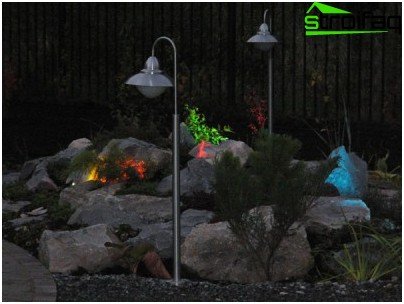
Muted decorative lighting of a stone slide
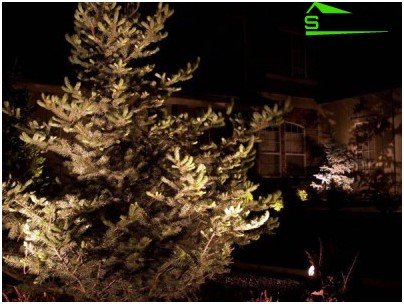
Accent (directional) tree lighting
And now let’s talk about those lamps with which all this light extravaganza is arranged.
The choice of light sources for the garden
As mentioned above, for functional lighting, “floor lamps” or spotlights are most suitable. It is with their help that it is most convenient to create good lighting of the working and residential areas of the estate. The variety of design of lamps allows you to choose exactly those that are most harmoniously combined with the general style of the whole territory.
Even more varieties of luminaires for decorative illumination are low spotlights, bat-type lanterns, balls of various designs, LED strips and many other lampions with matte, multi-colored, elaborate or strict lampshades. Again, the choice of design for decorative fixtures should be based on the general style of the estate.
But the design of the lamps is enough, now we will analyze two types of lighting devices depending on the power source. So, now most often used lampions working:
- from the general power supply network
- from solar panels
Each category of fixtures has its own advantages and disadvantages. Want some details? You are welcome.
Luminaires connected to a common network
The biggest advantage of this type of lighting will be a huge variety of lamps used in fixtures. Here, and ordinary incandescent lamps, and halogen lamps, and fluorescent, and LED – giving light in various shades. In addition, our habit of standard solutions considers it more comfortable to use the option with which we have been familiar for a long time.
But! This lighting method has two big drawbacks (just huge!):
- complexity and high installation cost – the cable for powering all the fixtures included in your lighting design project should be laid underground (it is unlikely that you will be pleased with a network of wires that entangle your estate from all sides), taking into account all the plantings, drainage and other systems necessary for normal plant growth
- constant payment of electricity (increasing every day)
We will not even talk about smaller flaws, such as maintenance complexity, periodic replacement of burned out lamps and dependence on the electricity supply system (i.e. power surges and power outages)..
Solar Powered Street Lights
This lighting method has more advantages:
- independence from a paid power supply system
- ease of installation (you can stick, dig or hang such lamps anywhere in your garden, even the most inaccessible, you just need enough sunlight to get on the photocell during the day)
- long service life (up to 25-30 years)
- ease of maintenance and operation (just periodically wipe the dust from the photocell, and turning it on and off automatically)
- safety (currents of 12 V are used)
- environmental friendliness (lamps are made of safe materials)
And the biggest drawback of a solar-powered lighting system will be the high purchase price of the fixtures. But you don’t have to pay more for anything – neither for installation, nor for electricity, nor for maintenance.
Now that you have familiarized yourself with the minimum information about the peculiarities of lighting the landscape gardening zone of a country house, you can easily do the lighting design of your summer cottages. Is it worth it to do the lighting project yourself or entrust it to a professional designer – it’s up to you. But cable laying and other technical installation works of a standard lighting system, operating from a common electrical network, clearly need the presence of a specialist, except that you yourself are well versed in the electrode. But be that as it may, any owner can make his garden fabulous. And may the cosiness and extraordinaryness of your garden please you!




